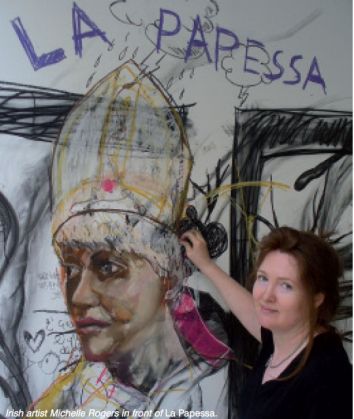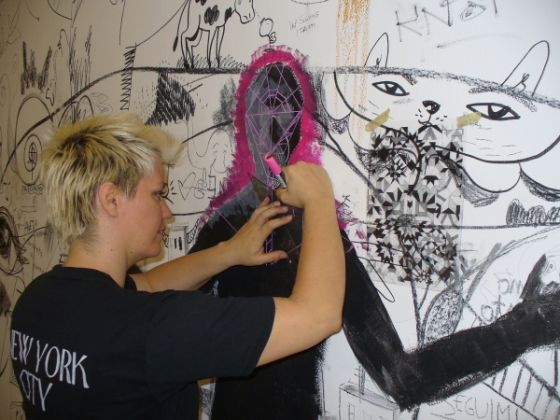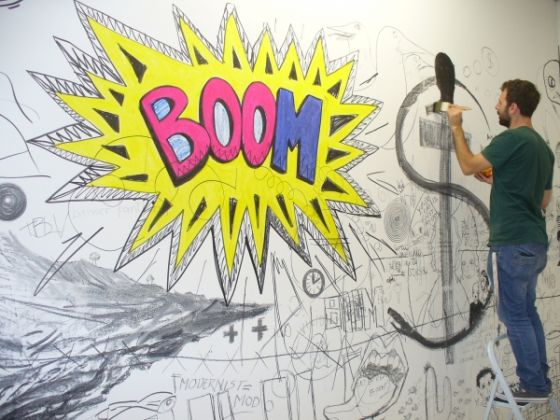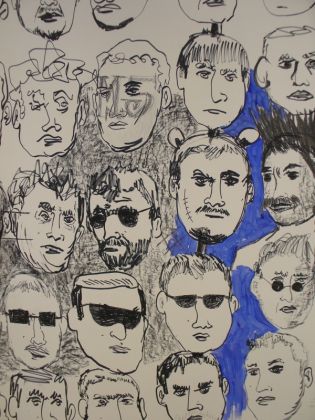An exciting initiative encourages artists to leave their mark on the walls of the Swiss Institute of Rome
While the capital’s modern galleries strive to retain their cutting-edge credentials, the Swiss Institute of Rome offers a liberating alternative to artists and non-artists alike. The Draftsmen’s Congress invites participants to use pencils, paint and ink to respond freely to topical issues such as politics, religion and the economic crisis. However, instead of being prompted to express themselves within the confines of a canvas or commenting neatly in a visitor’s book, the public can decorate the building’s white-washed walls and polythene-covered floors.
The Congresso dei disegnatori takes place in parallel with the recently finished seventh Berlin Biennale, curated by Poland’s Artur Żmijewski, an acclaimed artist who is particularly interested in the power of art and its relationship to politics. Amid declining state support for the arts in European countries such as Britain, the Netherlands and Italy, Żmijewski transformed the biennale into a political platform in which the public could explore and comment on the effects of art in society.
Drawing on his social activist roots, Ż mijewski set about creating a “Solidarity Action” involving a network of like-minded art institutions across Europe. In addition to the Swiss Institute in Rome, the other participating bodies are in Poland, Germany, Sweden and at the ESC Atelier Autogestito in Rome’s S. Lorenzo district. The project’s launch at the Swiss Institute on 4 June was overseen by Paweł Althamer, another leading Polish artist who kick-started the initiative in Berlin’s deconsecrated St Elisabeth Church.
The Draftsmen’s Congress allows people to enter into a visual dialogue in which images are just as powerful as words and artists are given free rein to draw whatever they wish. On arrival, visitors and curious passersby are provided with black markers or charcoal and encouraged to go wild. The walls of the institute are plastered with social commentary, mostly of a political and religious kind. There is a mixture of the serious, the silly and the surreal. One sign says When a platypus loves a flamingo it’s forever while nearby a large seagull implores us not to believe what we see. All around there is an eclectic mix of cartoons, Vikings, rock stars, even flying elephants. Handprints replace footprints on the stairwell. Most of the writing is in English but some of the Italian messages range from the philosophical – L’arte contemporanea non esiste and C’é troppa storia in questa città – to the joyous – Champagna! and Viva la libertà!
Collaborating with the institute for the duration of the show is Sicilian artist Orazio Battaglia, who exhibited at the Casa delle Letterature over Christmas alongside the late Edith Schloss. The softly-spoken Battaglia evidently revels in helping the project grow and estimates that up to 400 people left their mark on the opening night, among them about 100 Italian, Swiss and international professional visual artists. Since then there has been a steady stream of visitors from Rome and all over the world, and Battaglia has watched the walls come to life. “Today a group of 30 children aged six to 16 left clear traces of their visit,” he said, “and tomorrow they are coming back to draw some more.”
Although the venture began in monotone, colours have begun appearing around the building’s inner courtyard and vast downstairs exhibition space. Indeed, part of the project’s appeal is seeing the drawings metamorphose with the inventive interjections of a succession of artists. One of these was American Christine Finley, who is based in Rome and whose Colpo d’Occhio exhibition just finished at the FDA gallery in the city centre. At the institute she enlivened an already-painted silhouette of a man’s body using her trademark geometric designs. She told Wanted in Rome: “It was inspiring to walk into a giant community drawing; this show is a perfect example of free art. I love to participate with tons of other people, it is so creative and uplifting to see how talented everybody can be when provided with an open forum.”
Another Rome-based artist, Michelle Rogers, agrees: “It was exciting to see all the different ways that people responded – a really unique and unifying experience.” In the past the Irish artist’s human rights-themed paintings have won her commissions from Amnesty International, and much of her work celebrates women. Using pastels, Rogers drew a large portrait of a female pope inspired by her fondness for the mediaeval legend of Pope Joan. The artist dedicated her pastel Papessa to the recent Rome visit by America’s Leadership Conference of Women Religious (LCWR), which the Vatican charged with promoting “radical feminist themes incompatible with the Catholic faith.”
Meanwhile over in S. Lorenzo the project at the ESC has a freer, more underground feel to it, in keeping with the surrounding bohemian district. The independent, artist-run collective has been occupied since 2004 and organises regular events to promote social justice. In contrast to the Swiss Institute’s salubrious address in the environs of Via Veneto, the ESC sits at the quiet, ramshackle end of the funky Via dei Volsci, near the occupied Cinema Palazzo.
Although it embraces the same manifesto as the Swiss Institute – and evidently has a few artists in common – the atmosphere is somewhat different. Inside, a mixture of young Italian and foreign artists toast a successful afternoon’s work with plastic cups of beer while they help each other translate the more provocative and humorous messages on the walls.
In both establishments there is a warm welcome extended to anyone keen to add their contribution. The initiative ends on 20 July, when the Swiss Institute closes for the summer. Its walls will return to their original white but the exhibition will live on in photos, film and a future publication.
Whether professional or amateur and whatever your politics, there is still time to leave your mark in a project whose only limit is the height of the ceiling.
Andy Devane





























